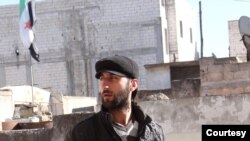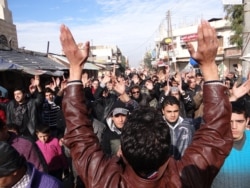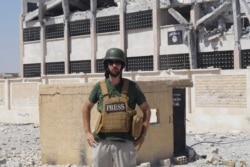When the uprising against the government of Syrian President Bashar al-Assad started in 2011, Eyad Aljarod picked up his camera and took to the streets.
Aljarod, now 34, quickly became an active figure documenting the anti-government protest movement in his hometown of Saraqib in Syria’s northwestern province of Idlib.
“Because something like that had not happened in Syria before, I felt that documenting such moments was very significant,” he told VOA. “Filming the protests wasn’t only to let the world see what was taking place in Syria, but it was also a personal desire for me to contribute to the revolution.”
A math teacher by training, Aljarod was one of hundreds of young activists who became part of what is commonly known as citizen journalism: a new phenomenon in the country.
Before 2011, media were heavily centralized by the Syrian government, so the emerging local and regional news networks relied largely on citizen journalists to cover the uprising.
Such coverage became more difficult as opposition to Assad splintered into extremist groups vying for control and a violent decade that has left the country divided into three distinct regions. Journalists were left navigating red lines in each of these regions or in some cases, having to flee because of threats.
Overall, Syria has become one of the most dangerous countries in the world for journalists, data from local and international rights groups shows.
The Syrian Center for Journalistic Freedoms (SCJF) has recorded 1,363 violations against journalists including killings, arrests, harassment from various groups since 2011. It has documented 10 cases of abuse just this year.
Data from the New York-based Committee to Protect Journalists (CPJ) shows at least 139 journalists killed for their work in Syria, and the Paris-based Reporters Without Borders (RSF) says hundreds have been arrested or kidnapped in Syria since 2011.
Syria is one of several Middle Eastern countries that experienced a popular uprising in the early months of 2011. Protests that started in Tunisia spread into large-scale rallies that helped topple authoritarian leaders in that country, along with Egypt and Libya.
But hopes for a path to democracy have been dashed as militants, rival governments and conflicts continue to threaten the countries’ prospects of becoming relatively peaceful. In nearly all, governments moved to crush dissent and critical voices, often using anti-terrorism and national security laws as a cover to imprison journalists and others.
Multiple persecutors
In the early days, Syrian forces went after those who covered anti-government demonstrations. But as the conflict developed and rebels and other anti-government forces took control of more territory, journalists had more adversaries.
These generally fell into three areas: the northeast, controlled by the U.S.-backed Syrian Democratic Forces; the northwest, mostly controlled by Turkey-backed militia groups and other Islamist elements; and the rest of the country, controlled by Syrian government forces and its allied militias, many of whom are backed by Iran.
“Local groups enforce their local censorship regimes in Syria and in many ways, Syria is divided not only by local groups but also by regional influence,” said Sherif Mansour, Middle East and North Africa program coordinator, at CPJ.
“So there is Russian support, Iranian support and even support from Gulf countries, and these types of support come with condition, meaning we see internet and radio censorship, not only in regime areas but also in opposition and Kurdish areas,” he said.
Journalist and filmmaker Aljarod told VOA he left Syria in 2013 “because of the many threats that were made against me by Islamists, including Ahrar al-Sham.”
Ahrar al-Sham, a coalition of several extremist groups in the Idlib area, was one of the first rebel groups that fought Syrian government forces. Local activists accused the group of targeting individuals who were critical of its extremist ideology.
“I left Syria because Daesh was gaining control while Ahrar al-Sham and al-Nusra Front [a militant group with links to al-Qaida] were already at their peak,” Aljarod said, using an Arabic acronym for the Islamic State terror group. “The situation quickly became terrifying for active people like me.”
Syria is one of the countries with the largest number of journalists going into exile since 2011, according to CPJ, which has helped more than 100, including 70 from opposition areas in the north and east.
Off limits
Over a decade of war, foreign news organizations became reluctant to send in reporters.
“There has been a steep decline in that aspect after many have seen the gruesome killing of foreign reporters, and even local reporters, by the Islamic State and its affiliates,” Mansour said.
The U.S. journalists James Foley and Steven Sotloff, and Japanese freelancer Kenji Goto, were taken hostage and later murdered in Syria by the Islamic State group, which broadcast the killings on social media.
“This has resulted in a lot of media outlets reconsidering the price of sending people into the conflict,” Mansour said. “But there is also a growing apathy or coverage fatigue in a civil war that has dragged on for several years.”
A reporter who requested anonymity told VOA that he started his journalism career in 2012 as a fixer and translator for foreign journalists.
“But that has changed in the past few years since less and less reporters travel to Syria,” he said. “I now work as a freelancer for several Western media outlets that I used to worked with as a fixer.”
It is less risky and even cheaper for foreign outlets to hire a local reporter, the journalist said.
In areas recaptured by government forces, many journalists who decided to stay witnessed retaliation from government forces and their affiliates.
Ali, a journalist who gave only his first name, remained in his hometown in Homs province after it was retaken by Syrian troops from rebels in 2015.
“Although I have stopped my journalistic work for years, I still face intimidation and harassment from the regime and its militias,” he told VOA via a messaging app.
“When the regime returned to my hometown, I was arrested for several weeks for ‘working with terrorists,’ even though I only covered the protests and uploaded videos on YouTube,” he said. “After they released me, I thought things will be fine, but they kept taking me for questioning and insulting me. It is their way of making sure that I won’t go back to journalism.”
Limited freedoms
Syria’s northeast, which has been under the control of U.S.-backed Syrian Democratic Forces since the beginning of the conflict, is viewed as marginally more open for media.
The semiautonomous region is largely seen as friendly to international journalists, but local reporters risk arrest or harassment for coverage deemed critical of the local administration, according to media watchdogs.
In a statement last week, Reporters Without Borders (RSF) said it was alarmed by an increase in arrests of journalists by the SDF.
The SDF has denied involvement with those arrests.
“As a military force, the Syrian Democratic Forces is not responsible for public law enforcement and is not authorized to take legal action against individuals,” the SDF said in a March 11 statement.
The group added that legal actions concerning individuals in northeast Syria fall under the responsibility of local forces, which are part of the Autonomous Administration of North and East Syria.
Local journalists in that region have voiced concerns about the limits placed on their reporting.
“There are many issues that we as journalists simply cannot cover,” said Siwar Majid, using a pseudonym that he employs when reporting to avoid retribution from local authorities.
Majid, who reports in the city of Qamishli, told VOA that “topics such as security and oil deals between the SDF and other forces are considered sensitive, so if we covered them, we would face retaliation from security forces.”
“When we get information on such tabooed issues, we use a pseudonym to publish them with websites that are based abroad,” he said.
Wladimir van Wilgenburg, a Dutch journalist who reported from northeast Syria for the first time in 2013, says reporting on the ground gives journalists unique insights into the conflict.
Although Wilgenburg reported on other parts of Syria, he couldn’t travel there while in northeast Syria.
“I did not consider traveling to other parts of Syria because it wasn’t safe, and in general areas under YPG [the main group within SDF] control were much safer for foreign journalists,” he said.
Since 2013, Wilgenburg has traveled to northeast Syria many times and seen changes in how local authorities affiliated with the SDF treat local journalists.
“Comparing the current situation in northeast Syria to several years ago, I would say it is a bit better,” he said. “In the past, critical reporters would be expelled, but recently it has been mostly like short-term arrest sentences.”
But while conditions in the northeast are marginally better, for journalists in other parts of Syria, the safest option has often been to leave.
“Amid a bleak environment for journalists and activists, leaving the country wasn’t just the safest option,” said Aljarod, who used to report in Idlib. “It was really the only option.”







